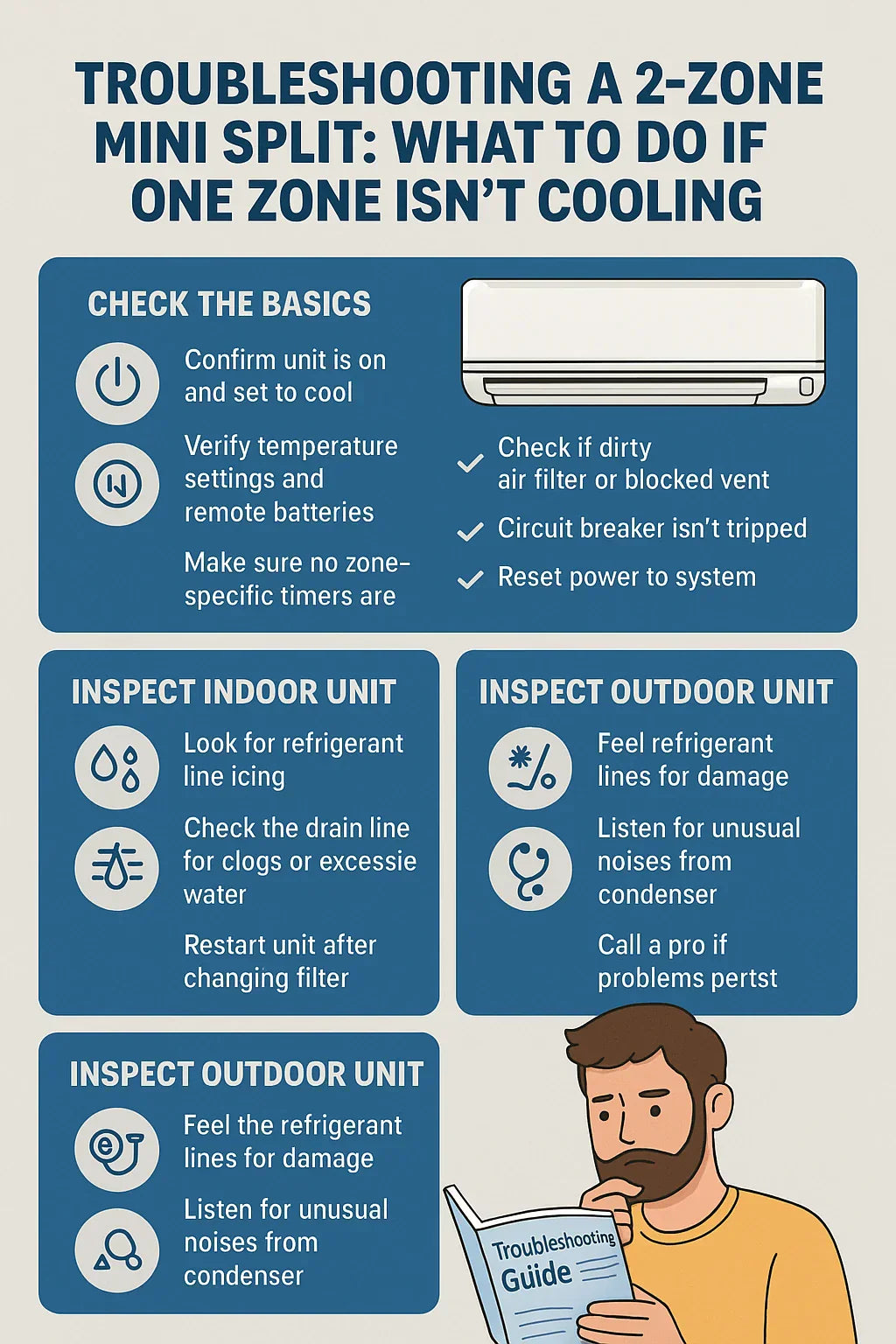🌡️ Introduction: When One Zone Goes Warm
So, your 2-zone mini split has been doing its job beautifully—until one zone suddenly stops cooling. Whether it's Jake's home office or your master bedroom, a single zone acting up can throw off your comfort and energy efficiency. Before you panic or call in a technician, there are a few simple steps you can take to troubleshoot the problem.
This guide will walk you through exactly what to check, what tools you might need, and when it's time to call a pro.
⚒️ Step 1: Start with the Obvious
✔️ Check the Remote or Wall Control
-
Is the unit in cooling mode?
-
Temperature setpoint may be too high—try dropping it a few degrees.
-
Check for dead batteries in the remote.
-
Is the unit set to fan-only or dry mode by mistake?
✔️ Is the Zone Getting Power?
-
If the indoor head isn't turning on, check the circuit breaker.
-
Some systems have individual fuses for each indoor unit—look for a tripped fuse or breaker.
-
Reset the unit by cutting power for 5 minutes, then turning it back on.
✔️ Inspect the Air Filter
-
Remove the cover and inspect the air filter.
-
Dirty filters can block airflow and prevent proper cooling.
-
Clean with a vacuum or wash with mild soap and water. Let it dry before reinserting.
🌬️ Step 2: Inspect Airflow and Louver Position
Sometimes the zone is cooling, but the air isn't moving where it should.
-
Check that louvers are not stuck shut.
-
Use the remote to adjust swing direction.
-
Make sure there's no furniture blocking the air handler.
-
Put your hand in front of the unit: weak or no airflow could mean a fan issue or clogged coil.
💡 Step 3: Look for Freeze-Up Signs or Condensate Issues
If there's ice on the coil, your system may be:
-
Low on refrigerant
-
Running too long in high humidity
-
Suffering from poor airflow
How to handle it:
-
Turn the unit off and let it thaw.
-
Clean the filter and check the drain line.
-
Check that all windows/doors are closed in that zone.
Water dripping or leaking?
-
Condensate drain may be clogged.
-
Check for visible water in the tray.
-
Clean with a pipe cleaner or distilled vinegar.
🔌 Step 4: Outdoor Unit and Line Set Troubleshooting
Your 2-zone system shares an outdoor condenser—if one zone fails but the other works, the issue may be zone-specific:
-
Feel the line set near the non-cooling zone. Is it cold to the touch when running?
-
Look for signs of damage to the insulation.
-
If you see oil residue near the flare nuts or fittings, you may have a refrigerant leak.
Also check:
-
Fan is running at outdoor unit
-
Nothing is obstructing airflow
-
Line set is not kinked or bent
⚖️ Step 5: Decode Error Lights or Codes
Most mini splits flash a code on the indoor unit or remote when there's a fault.
-
Count the blinks or check the number code.
-
Cross-reference with your unit’s manual or manufacturer website.
-
Some common 2-zone error codes:
-
E6: Communication error between indoor and outdoor units
-
U4/U7: Power issue or zone mismatch
-
P1: Low refrigerant or pressure imbalance
-
Manufacturer references:
🚧 When to Call a Pro
If these DIY steps don’t fix the issue, it might be time for professional help.
Call an HVAC technician if:
-
One zone is totally unresponsive
-
You're seeing persistent error codes
-
You suspect a refrigerant leak
-
Unit is short-cycling or making odd noises
-
Coil is freezing repeatedly even after filter cleaning
Pro tools like manifold gauges, leak detectors, and thermal imaging are needed for next-level diagnostics.
📅 Jake’s Story: What Actually Happened
Jake's second-floor zone stopped cooling last July. Here’s what he did:
-
Checked and cleaned the filter.
-
Found no power issues.
-
Noticed the indoor coil had ice buildup.
-
Let it thaw and restarted—still no cooling.
-
Called in a tech who found a low refrigerant charge and a slow leak in the line set flare.
Outcome? Fixed in one visit, and Jake learned to check line insulation more often.
🌐 External Resources for Further Reading
🌄 Final Tips to Keep Your Zones Running
-
Keep filters clean monthly.
-
Don’t block vents or airflow.
-
Regularly inspect drain lines.
-
If one zone acts up, address it early—small issues snowball fast.
A 2-zone system is efficient and powerful, but only when both zones stay in sync. Use this guide to keep your comfort consistent year-round—just like Jake.
In the next topic we will know more about: How Much Does a 2-Zone Mini Split Cost? Budgeting for Equipment, Accessories, and Labor







